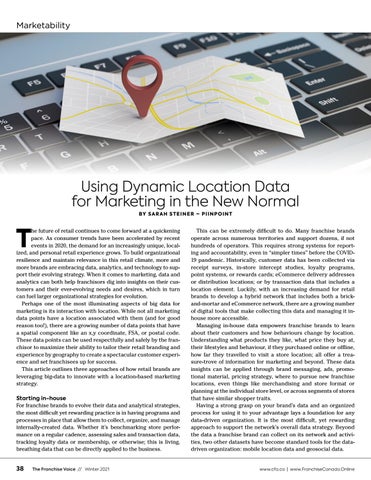Marketability
Using Dynamic Location Data for Marketing in the New Normal BY S A R A H S T E I N E R – P I I N P O I N T
T
he future of retail continues to come forward at a quickening pace. As consumer trends have been accelerated by recent events in 2020, the demand for an increasingly unique, localized, and personal retail experience grows. To build organizational resilience and maintain relevance in this retail climate, more and more brands are embracing data, analytics, and technology to support their evolving strategy. When it comes to marketing, data and analytics can both help franchisors dig into insights on their customers and their ever-evolving needs and desires, which in turn can fuel larger organizational strategies for evolution. Perhaps one of the most illuminating aspects of big data for marketing is its interaction with location. While not all marketing data points have a location associated with them (and for good reason too!), there are a growing number of data points that have a spatial component like an x,y coordinate, FSA, or postal code. These data points can be used respectfully and safely by the franchisor to maximize their ability to tailor their retail branding and experience by geography to create a spectacular customer experience and set franchisees up for success. This article outlines three approaches of how retail brands are leveraging big-data to innovate with a location-based marketing strategy. Starting in-house For franchise brands to evolve their data and analytical strategies, the most difficult yet rewarding practice is in having programs and processes in place that allow them to collect, organize, and manage internally-created data. Whether it’s benchmarking store performance on a regular cadence, assessing sales and transaction data, tracking loyalty data or membership, or otherwise; this is living, breathing data that can be directly applied to the business.
38 The Franchise Voice // Winter 2021
This can be extremely difficult to do. Many franchise brands operate across numerous territories and support dozens, if not hundreds of operators. This requires strong systems for reporting and accountability, even in “simpler times” before the COVID19 pandemic. Historically, customer data has been collected via receipt surveys, in-store intercept studies, loyalty programs, point systems, or rewards cards; eCommerce delivery addresses or distribution locations; or by transaction data that includes a location element. Luckily, with an increasing demand for retail brands to develop a hybrid network that includes both a brickand-mortar and eCommerce network, there are a growing number of digital tools that make collecting this data and managing it inhouse more accessible. Managing in-house data empowers franchise brands to learn about their customers and how behaviours change by location. Understanding what products they like, what price they buy at, their lifestyles and behaviour, if they purchased online or offline, how far they travelled to visit a store location; all offer a treasure-trove of information for marketing and beyond. These data insights can be applied through brand messaging, ads, promotional material, pricing strategy, where to pursue new franchise locations, even things like merchandising and store format or planning at the individual store level, or across segments of stores that have similar shopper traits. Having a strong grasp on your brand’s data and an organized process for using it to your advantage lays a foundation for any data-driven organization. It is the most difficult, yet rewarding approach to support the network’s overall data strategy. Beyond the data a franchise brand can collect on its network and activities, two other datasets have become standard tools for the datadriven organization: mobile location data and geosocial data.
www.cfa.ca | www.FranchiseCanada.Online
